 |
||
|
Heaven on Two Wheels |
||
|
For those energetic enough in the saddle, there are rich rewards awaiting them in Tzia and Delphi. We look at the two exhilarating routes By Brady Kiesling |
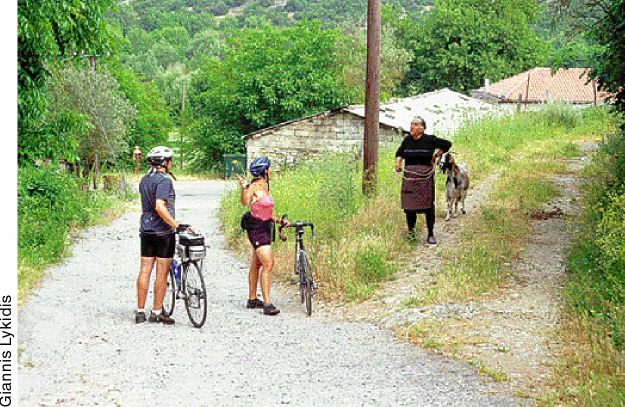 Ancestral wisdom in the Peloponnese |
|
|
beckon wider than we think. In late May I tried two aspects of the cycle-touring experience in Greece, rugged individualism on public transportation and a new venture in high-end cycling tourism. Both are fantastic.
Hatred of summer traffic jams at the ferryboats long kept me away from Tzia (anciently Kea). The Athens Suburban Railroad accepted Celeste and her pannier bags at the main Larisa Station without a whimper. Forty-five minutes later we rolled off at Koropi. From there, the port of Lavrio is an easy 90-minute ride, at first on the highway with trucks whizzing by, but then on a beautiful country road through Keratea. I wheeled my bicycle aboard the Marmari Express while my non-cycling partner still had her nose pressed against the glass of the orange KTEL bus (marked ΣΟΥΝΙΟ) she had caught outside the Ethniki Amyna metro station. |
||
| The 5km climb from Tzia's port of Korisia to the hidden island capital of Ioulis, a debilitating trudge for pirates, is 30 sturdy minutes on a multi-geared bicycle. Arriving without reservations allowed us to display our cardiovascular prowess by lugging bicycle and luggage up the maze of twisting stone stairways to Kyria Eleftheria's rent rooms. Riding to the upper edge of the village, a more discreet and dignified alternative, would have taken another 20 minutes on the main road. For the archaeologist, the bare-breasted goddess statues in rough clay from the Bronze Age site of Agia Irini are an excellent reason to visit Ioulis and its little museum. The cyclist's reason for staying in Ioulis, however, leaving aside the dramatic views and friendly restaurants, is that all the rest of Tzia is downhill from there. |
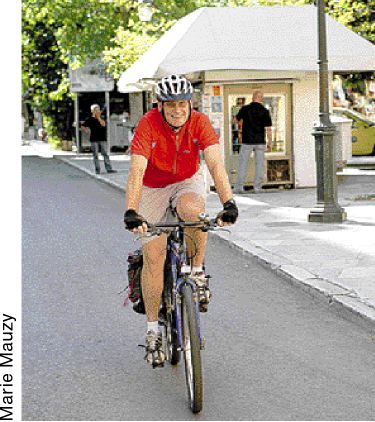 Brady Kiesling begins his quest |
|
| Tzia's villages were once tied to one another by a network of kalderimia, stone-paved mule tracks. Long stretches of eight footpaths have survived the bulldozers and are marked for tourists. On foot from Ioulis it is a 4- to 5-hour hike (Route 3) to the deserted beaches flanking the dramatic ancient sanctuary of Karthaia. By bicycle, the road to the Karthaia trailhead at Stavroudaki takes about an hour. From there, a fine kalderimi leads down to the sea, a 45-minute walk along a dramatic gorge. After a swim to wash off spider webs, one can scramble up the path to admire the bureaucratic talents of the Greek Archaeological Service. The European Union is paying to rebuild the romantic, inaccessible temple, potential lifetime employment in a beautiful setting. Once back atop the ridge and aboard your bicycle, check your brakes before the long, steep descent via the dirt road to the upscale beach of Koundouros. Then it is up and over a lower ridge to the larger beach at Pisses, and finally a slow, hot, return climb back to Ioulis. The ancient tower and chapel of Agia Marina are a worthwhile detour about halfway up the hill. From the summit, a painless quarter-hour sprint allows most of the sweat to dry before climbing aboard the 5.30pm Sunday ferryboat for a needed rest. But there was no time to dawdle on disembarkation at the port of Lavrio: the last train from Koropi on Sunday evening was at 8.35pm. Celeste and I made it with only eight minutes to spare. Freedom, glorious landscapes, and the silence and solitude to appreciate them properly, reward the independent cyclist. Tzia is an ideal weekend venture for a strong and determined rider. Not everyone likes empty beaches: fantastic cycling day trips to the Saronic Gulf islands of Aegina and Angistri are cheap, easy and safe even for complete novices. If fighting traffic down to Piraeus port is too daunting, the electric train to Piraeus (see box) costs 70 cents and drops you across the street from the port. Bicycles are welcome (and free) on any ferry. |
||
| The luxury route My friend Colleen had an empty saddle to fill from Delphi to Loutra Edipsou, the last leg of CycleGreece's twelve-day Sacred Sites & Spas tour. My luggage would ride in the "Sag Wagon", along with tools and extra water. The brand-new road bike she lent me was one-third lighter than Celeste, and it had just been serviced by one of Greece's most gifted bicycle mechanics. As we glided forth at 7.45am from our A-class hotel in Delphi, pedalling felt strictly optional. Poor Celeste... The little group I joined was resplendent in spandex, bronzed and toughened already by 500km of cycling the mountains of the |
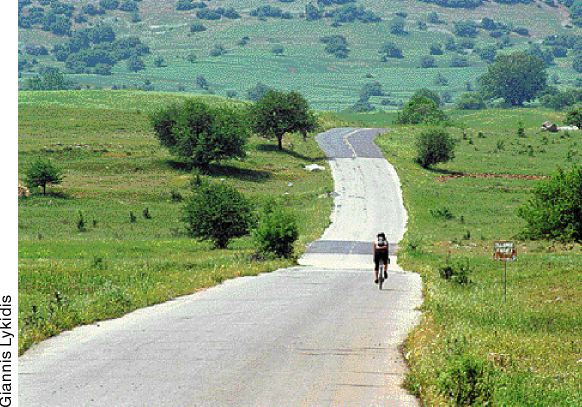 Et in Arcadia ego |
|
| Peloponnese. It included a former Iron-Man Triathlon champion (still-buff at 71, but gimpy knees kept her in the middle of the pack), a sunny-faced ranch mum from Salmon, Idaho, a religion professor from South Carolina and a pair of cycling lovebirds from the mountains of Colorado. I was billed as cultural enrichment. However, Greek law 710/1977 makes it illegal "to point out sites, historical monuments, or works of art, explain their importance and history, or provide general information about ancient or modern Greece" without a licence. After a friend was arrested for that crime on the Acropolis, it seemed prudent to let the official tour guide give the Authorised Version of ancient Delphi. She left out the sordid politics, but even without them our hardened cyclists were impressed. The sanctuary of Pythian Apollo had been an amazing compendium of the League of Nations, Lourdes, the Venice Biennale, a theatre festival, a track meet, a Swiss bank, a public records office and the Grand Canyon. If you threw in philosophers, tour guides, mad monks, a kosher butcher, Henry Kissinger and Dear Abby, the last two heavily drugged, the picture was still not quite complete. |
||
Aboard a modern bicycle, once lung-searing climbs become simply a test of patience, rewarded by a surge of happiness at the summit and an oxygen-fuelled burst of singing on the downhill. The 350m climb from Delphi to Arachova, site of our coffee break, seemed effortless. The weather was perfect, the views amazing. On the long, sweeping downhills the speedometer read 75km, but we slowed to a careful crawl in the narrow, jammed streets of Livadeia. We elected to skip the Oracle of Trophonios, once Livadeia's chief tourist attraction. Being dragged feet-first into a very narrow hole in the ground, to emerge completely disoriented several hours or days later, seemed less inviting than a salad lunch overlooking Livadeia's beautiful river. |
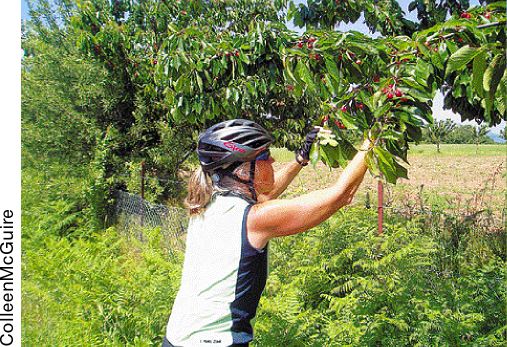 Stolen fruit tastes sweeter |
|
| Cycling got tougher as the sun blazed down on the flatlands of Viotia. The trees around the marble lion of Chaironeia, where Philip of Macedon conquered the Greeks in 338BC, were welcome shade. As we climbed the last big hill, one Colleen had forgotten to mention, Yiannis would drive by in the van to pour water on our heads. For my aching posterior there was no remedy but the sight of the straits of Evia. It came into view and our hearts soared magically. After 114km, souvlaki and cold beer consoled our wait at Arkitsa for the Evia ferry. And by 7pm we were at Loutra Edipsou, checking into the Thermae Sylla. I never really believed Greece had spas. The grim concrete bathhouses at Methana and Traianoupoli look from the outside like a good place to catch some lingering fungus. But on Evia my eyes and pores were opened. Thermae Sylla is named for its most famous customer (after Greta Garbo anyway), the Roman dictator Sulla, who in 84BC came here to cure his gout and frolic with actors. The site is now a gleaming five-star hotel and gourmet restaurant built over a powerful set of mineral hot springs. The huge, immaculate pools have jets of hot water to pummel the sore bits back into working order. A man in a white coat, apparently a doctor, checked my blood pressure beforehand to make sure my heart could withstand the shock of soft cotton towels after so many years of drying myself on grey sandpaper. |
||
The two nights at the spa were the reward for cycling glory I had mostly not earned. So while our triathlete and her friends wrapped themselves in kelp and had their long-suffering toenails burnished, four stalwarts rode the coast road 32km down to the lovely little town of Limni for a last workout and a tour of the charming local museum. Then it was back to the spa to admire our transformed and glowing trip-mates and dabble in hydromassage and gin-and-tonics. The next morning, after a last huge breakfast of fresh crepes, eggs, croissants, fruit, yoghurt and everything else, we cycled to the ferry. On the far side we dispersed with fond hugs and email addresses, some in the van with the bicycles back to Athens, some by taxi to the airport and new adventures in Santorini. |
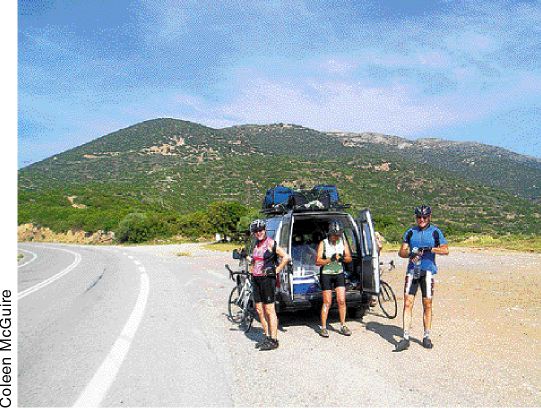 Around the Sag Wagon |
|
|
My new cycling friends were agreeably amazed by Greece. Roads hopelessly choked with automobiles miraculously open up to the intrepid cyclist, often with a smile and a wave. There were no mishaps, not even a snarling dog or flat tyre, on the smooth roads we mostly travelled. Rutted dirt roads branch off on all sides to unsuspected vistas and deserted beaches. The technical support and after-ride pampering were fantastic. And who would have thought the Greek countryside still had foxes and hedgehogs as well as ruined temples? The right equipment A feather-light, skinny-tyred road bike, though a joy to ride on smooth asphalt, limits your options. The sensible compromise for commuting in Athens, climbing Mt Hymettus and exploring remote island beaches is the lightest mountain bike you can afford: widish tyres, good brakes, 24 or 27 speeds, and front shock-absorbers. A rear suspension, fine for racing downhill over boulders, is worse than useless for anything more practical. Look for Shimano components and a minimum of flashy accessories. Consult a genuine bicycle shop (not a toy shop or Carrefour) for correct fit and proper setup, which are vital to your safety and happiness. Shops cluster off Omonia Square, for example in the arcade at 51 Stournari. A helmet is mandatory, as are sun-screen and water bottles. Cyclists sweat. To help maintain electrolyte balance, dilute a commercial sports drink with lots of water. Cycling gloves, cleated shoes/pedals, a basic trip computer and a rear luggage rack are good investments. Road Editions (www.road.gr) and Anavasi (www.mountains.gr) produce excellent maps. Bicycles on public transport Metro lines 2 and 3 do not allow bicycles. On the Piraeus-Kifissia electric train (Metro line 1), bicycles use the last door of the last car. Bicycles are banned at the Monastiraki, Omonia and Attiki transfer stations and on rush-hour trains (weekdays 6.15am-9.30am and 12.00-6.30pm). On the Suburban Railroad to Corinth or Koropi (tel 210 527-2000, www.proastiakos.gr), use the handicapped space. On OSE intercity trains (tel 1110, www.ose.gr), bicycles must be in the baggage car. This rules out the trains to Nafplio and Halkida, unless you dismantle your bicycle and camouflage it as hand baggage. KTEL buses to Lavrio and Rafina (tel 210-880-8080, www.ktelattikis.gr) accept bicycles when there is room and the driver feels like it. For other intercity bus routes, check www.ktel.gr and then telephone the relevant bus line. |
||
(Posting date 6 October 2006)
All articles of Athens News appearing on HCS have been reprinted with permission. |
||
|
||
|
2000 © Hellenic Communication Service, L.L.C. All Rights Reserved. http://www.HellenicComServe.com |
||

